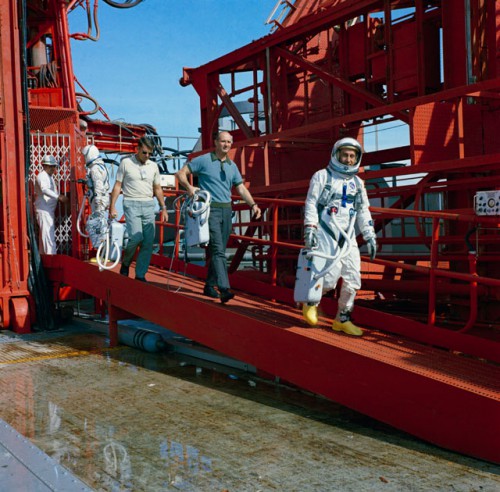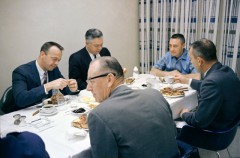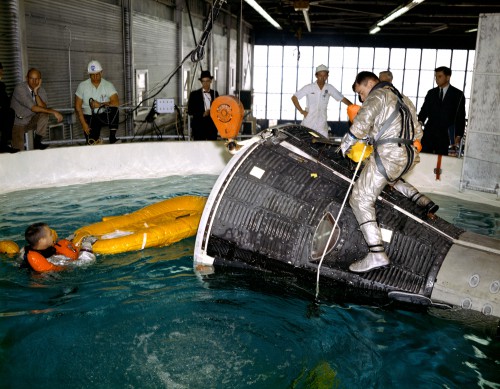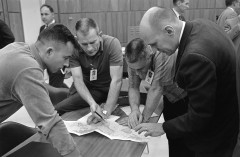
On the night before the Gemini 3 mission—50 years ago, this week—backup crewmen Wally Schirra and Tom Stafford went out on an errand in Coca Beach, Fla. Their journey took them to a deli, called Wolfies, on North Atlantic Avenue, at the behest of prime pilot John Young. “Young mentioned to me a day or so before launch that there was not a meal scheduled on the flight,” Schirra wrote in his memoir, Schirra’s Space, “since the flight was less than five hours.” Indeed, Gemini 3 was intended to be little more than a three-orbit test flight of the spacecraft which would enable America to evaluate many techniques needed to reach the Moon: techniques such as rendezvous, docking, long-duration flight, and spacewalking. Schirra and Stafford bought Young and his command pilot, Virgil “Gus” Grissom, a corned beef sandwich, “on rye with two dill pickle slices.” Their purchase would turn into one of the famous incidents of Gemini 3 … a mission mired with disappointment, right from the outset. Yet 50 years ago, today, on 23 March 1965, the first piloted mission got underway of a program which would successfully overcome many hurdles in America’s drive to plant boots on the Moon before 1970.
Schirra kept the sandwich in a refrigerator at Cape Kennedy, finally handing it to Young on launch morning, 23 March 1965. A grateful Young tucked it into one of his space suit pockets, intending to surprise Grissom with it in orbit. Ironically, a few months earlier, Schirra had no involvement with Gemini 3 at all. In fact, he had his sights set—with Young as his pilot—on another mission to demonstrate rendezvous practices in space. The original Gemini 3 crew would have seen Al Shepard, America’s first man in space, in command, paired with Tom Stafford. Their backups were Gus Grissom and Frank Borman. According to Deke Slayton, the co-ordinator of Astronaut Activities at the time, in his autobiography, Deke, “I figured to hand-pick the crews for the first four missions, since they had unique requirements.” Those requirements were an initial manned shakedown flight, two long-duration missions (lasting seven and 14 days), and the first rendezvous test.
Grissom had closely followed the development of Gemini, and Slayton wrote that he had given him command of the 14-day mission (Gemini VI), whilst Schirra’s disinterest in a lengthy flight led to an assignment to the rendezvous mission (Gemini V). Moreover, Borman was “tenacious enough” to handle 14 days in space and thus was teamed with Grissom. John Young would then joined Schirra on the rendezvous mission. Meanwhile, Gemini IV—the first mission to adopt a Roman-numeral form of designation—would include Jim McDivitt and Ed White for a seven-day test. In time, these plans shifted, America’s first spacewalk was added to Gemini IV, and delays in the arrival of fuel cells shortened the mission to four days. It was later realized that the Atlas-Agena rendezvous target for Gemini V would not be ready in time: The mission moved to Gemini VI, and Schirra and Young were shifted into a new role as backups to Shepard and Stafford on Gemini 3. Grissom and Borman then became the prime Gemini V team. Still, none of these changes caused quite as much heartache or dismay as the decision to drop Al Shepard from active flight status in the summer of 1963.

Several years earlier, he had complained about feeling light-headed during a game of golf. Every time he attempted to swing the club, he felt that he was about to fall over. It was an isolated, peculiar incident, which did not resurface again until the summer of 1963. It came with a vengeance, usually striking him in the mornings and taking the form of a loud metallic ringing in his ears, coupled with feelings of intense dizziness and nausea. At first, Shepard dealt with the problem himself: He saw a private physician, who prescribed diuretics and vitamins such as niacin, which had little effect. It did not stop Slayton from assigning him to command Gemini 3, and, indeed, Shepard and Stafford completed six weeks of training, visiting prime contractor McDonnell’s St. Louis, Miss., plant to watch their spacecraft being built. He told no one in the astronaut corps of the problem.
However, very soon it became impossible to conceal. An episode of dizziness whilst delivering a lecture in Houston, Texas, forced him to admit his concerns to Slayton, who sent him to the astronauts’ physician, Dr. Chuck Berry, for tests. In May 1963, Shepard was temporarily grounded. The diagnosis was that fluids were regularly building up in the semicircular canals of his inner ear, affecting his balance and causing vertigo, nausea, hearing loss, and intense aural ringing. Although the incidents were intermittent, they were sufficiently unpredictable and severe to ground him from Gemini 3.
Known as Ménière’s Disease, the ailment was a recognized but somewhat vague condition. Indeed, formal criteria to define it would not be established by the American Academy of Otolaryngology-Head and Neck Surgery until 1972. The academy’s criteria would describe exactly the conditions suffered by Shepard: fluctuating, progressive deafness (he would be virtually deaf in one ear by 1968) together with episodic spells of vertigo, tinnitus, and periodic swings of remission and exacerbation. Nowadays, it can be treated through vestibular training, stress reduction, hearing aids, low-sodium diets, and medication for the nausea, vertigo, and inner-ear pressure, such as antihistamines, anticholinergics, steroids, and diuretics. In mid-1963, however, the physicians who examined Shepard had next to no idea what caused it. Some even speculated that it was a “psychosomatic” affliction. More importantly, there was no cure.
His removal from flight status was temporarily revoked in August, with the prescription of diuretics and pills to increase blood circulation, in the 20 percent hope that it would clear up on its own. This allowed Shepard to be internally assigned to Gemini 3, but when the early diagnosis was confirmed and no sign of improvement was forthcoming, he was formally grounded in October. Not only was Shepard barred from spaceflight, but he also could not fly NASA jets unless accompanied by another pilot. Subsequent examinations revealed that he also suffered from mild glaucoma—a symptom of chronic hyperactivity—and a small lump was discovered on his thyroid. It was surgically removed in January 1964 and, the press announced, “would have no impact on his status in the space programme.” In reality, Shepard had been effectively grounded for months by that point.

One evening, at the Rice Hotel in downtown Houston, Shepard pulled Stafford aside and asked pointedly if Slayton had mentioned anything about Gemini 3. No, Stafford replied, and could only listen open-mouthed as his former crewmate told him about the dizziness, the vertigo, the Ménière’s diagnosis … and the bombshell that Shepard was grounded. In his autobiography, We Have Capture, Stafford recalled fearing for his own place on the mission, and, indeed, in mid-April 1964 the crew changes were announced. Slayton moved Gus Grissom up from Gemini V to Gemini 3 and replaced him with Gordo Cooper. Unluckily for Stafford, however, Slayton felt that John Young was a better personality match with Grissom and named him as Gemini 3’s new pilot. He had nothing against Stafford, but revealed in his autobiography that “Tom was probably our strongest guy in rendezvous, so it made sense to point him at [Gemini VI], the first rendezvous mission.”
Stafford learned of his removal from the Gemini 3 prime crew from one of the flight surgeons, Duane Ross, who told him that he was now on Gus Grissom’s backup team, paired with Wally Schirra. Grissom’s original pilot, Frank Borman, would be “held for later” and another mission. In Gus Grissom: The Lost Astronaut, biographer Ray Boomhower cited fellow astronaut Gene Cernan as remarking that Grissom’s and Borman’s strong-headed egos were too large to fit one mission. Indeed, in an April 1999 oral history for NASA, Borman hinted that he “went over to [Grissom’s] house to talk to him about it … and after that I was scrubbed from the flight.” Meanwhile, on 13 April 1964, the four-man unit for Gemini 3 set to work. Only days earlier, an unmanned test (Gemini 1) to assess the compatibility of the spacecraft and its Titan II launch vehicle had proven a remarkable success. A second flight, Gemini 2, in January 1965, was similarly successful.
Only days after Gemini 2’s splashdown, it was announced that late March seemed the most achievable target to launch Gus Grissom and John Young on the first manned mission. By this time, the men and their backups had been training for almost a year, and Tom Stafford remarked that they “became virtual citizens of St. Louis, flying in on Sunday night or Monday morning in our T-33s and T-38s, spending days at the McDonnell plant at Lambert Field then going back to Houston on Thursday or Friday.” At St. Louis was the Gemini mission simulator, which provided them with the sights, sounds, and vibrations that they could expect on a real flight; moreover, it was adaptable for each crew, whose objectives would differ markedly.

Grissom, an Air Force officer promoted from captain to major in July 1962, would become the first man to be launched into space twice. He had been one of the earliest astronauts assigned to Project Gemini, and the spacecraft reflected, among other things, his short stature. Whereas Grissom, at a little over five feet tall, could comfortably fit the cockpit, the six-foot Stafford “was jammed in, especially when I had to wear a pressure suit and helmet.” “Eventually,” wrote Stafford, “the McDonnell engineers removed some of the insulation from the inside of the hatch to create a slight bump that gave us room for our helmets.” First fitted for Gemini VI—which Stafford flew, alongside Schirra—it became known as “The Stafford Bump.” Among the astronauts, Gemini had already earned itself another moniker, “Gusmobile,” because Grissom was the only man small enough to scrunch himself into his seat and close the hatch without banging his head.
During their early months of training, the four men closely monitored the development of the “real” spacecraft at St. Louis, watching as it passed through various systems tests and inspections, then spending hours in its cockpit. Elsewhere, in Dallas, Texas, they participated in exercises on a Gemini moving-base abort simulator, which projected their ascent profile in striking detail and enabled them to rehearse their responses to malfunctions. At Ellington Air Force Base, not far from the Manned Spacecraft Center (MSC) in Houston, Texas, they were dunked in a “flotation tank” to practice getting out of a boilerplate mockup of the Gemini capsule, with and without space suits, both floating and submerged. Only weeks before launch, in February 1965, Grissom and Young rode a boat out into the Gulf of Mexico to a mockup capsule, which they had to board and run through their post-splashdown checklists, their emergency egress procedures, and the opening of their one-man life rafts.
Mission planning sessions, centrifuge training at Johnsville, Penn., space suit fit checks, physical exams, and preparation for the Gemini 3 experiments quickly turned their training schedule into an unending marathon. “The days just seemed to have 48 hours, the weeks 14 days, and still there was never enough time,” Grissom would recall later. “We saw our families just enough to reassure our youngsters they still had fathers.” By the time the mission simulator had been set up at Cape Kennedy in October 1964, it would become the astronauts’ second home: Grissom would put in more than 77 hours of training in it, rehearsing every phase and every minute of his five-hour mission, with Young slightly eclipsing him at 85 hours. As launch day neared, Grissom had sat through 225 abort scenarios, compared to 154 for his rookie pilot.
By February, when queried by journalists, Grissom confirmed that he and Young were ready to go. Indeed, even NASA Administrator Jim Webb confidently expected a launch as soon as 15 March. Although it would only last for five hours, Gemini 3 would showcase the most advanced piloted spacecraft of its generation … and the key to achieving the exalted goal of American bootprints on the lunar surface before the decade’s end.
The second part of this article will appear tomorrow.
Want to keep up-to-date with all things space? Be sure to “Like” AmericaSpace on Facebook and follow us on Twitter: @AmericaSpace




Ben,
A greatly written article and I can not wait for the second part. You capture and remind us of the small details and personal aspects of those heady early missions. Your insight of the uniqueness of the men and the machines they flew made each mission exciting – you have captured that in this story.
John Young now joins the exclusive group of astronauts and cosmonauts who celebrate the 50th anniversary of their first space flight.
I saw Alexi Leonov on NBC Nightly News 22 March regarding the anniversary of his spacewalk, and at 80 years old he looks great, very active and healthy. If only he and Ed White could have met to share their experiences. May Cosmonaut Leonov have many more years.
Yes, word was that Leonov may have considered breaking John Glenn’s age record for oldest person in space.